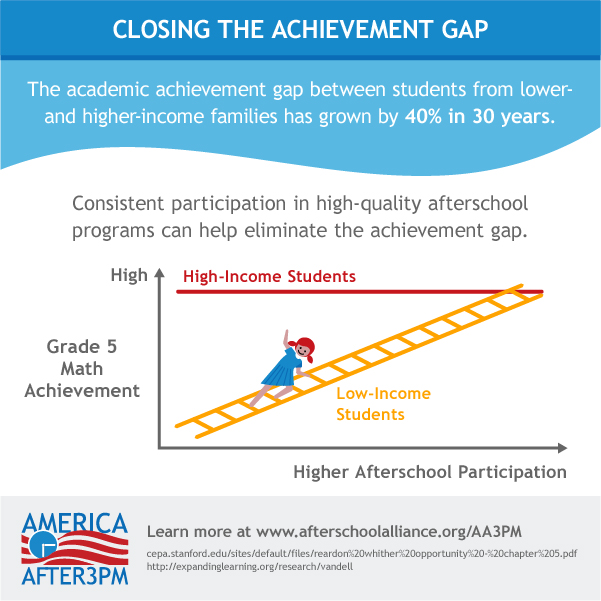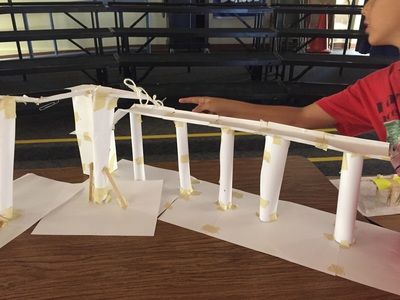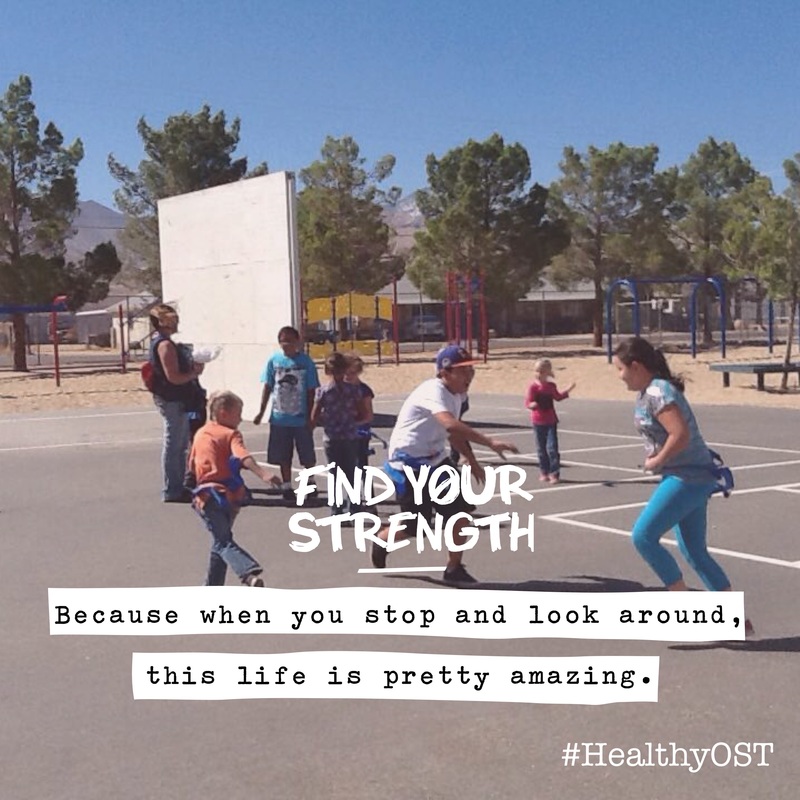|
What does it mean to build a bridge? According to the book, Javier Builds a Bridge, building a bridge can mean more than the physical, literal bridge. "Bridging the gap" is an educational catch phrase, but what does it mean? The achievement gap is the space between high and low income students. Afterschool Alliance's study, America After 3PM shows that afterschool can help narrow that gap. Bridges bring people together, and can also connect them, bringing a person from one place to another. We cross that bridge when we get to it, and maybe burn the bridge behind us. Things in our past are water under the bridge. We mention bridges when we talk about making a change. Water is often depicted as turbulent and difficult, and bridges are the safe crossing. Sometimes, childhood can be a turbulent time. Family/home time and school are often the opposite sides of a chasm.. Having a safe place to go afterschool can give students a bridge between the school day and home. Bringing families into our school world can further bridge those sides. Like Javier, in Javier Builds a Bridge, working together, building something physical, playing and laughing can bring families a sense of connection, as well as connect those families to educators. High Desert Leapin' Lizards holds a culminating event for each of our STEAM units, but the To Get to the Other Side: Designing Bridges was a special one, not just for the STEAM component, but for the metaphorical bridges we were able to cross. At the event, I watch hesitant parents slowly relax, and join their student in building with blocks, 3x5 cards, marshmallows and spaghetti, and graham crackers and icing. As they left, with their plates, I saw big smiles and student bragged proudly that they built the house/tower/bridge, and that their parent/grandparent/sibling helped. As we build our Mini-Golf installations for our next unit, and head toward our next culminating event, which will be our Lights on Afterschool event, we hope that we can all further construct solid bridges that can keep us all together!
0 Comments
At the end of last school year, afterschool staff got together and decided on some STEAM topics for the 2015-2016 school year. One of the most popular topics (after dinosaurs, which we ARE going to do this year) was towers. I couldn't figure out how to make "towers" into a full unit, or even a 2 week mini unit. I wanted to do bridges...which led me to Engineering is Elementary (http://www.eie.org/). Granted, we've used the EiE Engineering Adventures curriculum, which is made specifically for afterschool and other OST (out-of-school time) programs. EiE is made for regular school day classrooms and teachers, so we've never looked seriously at the curriculum. When I looked, and saw that the majority of the unit revolves around a story book, I really wanted the opportunity to do this unit! Or course, we have to adapt a little. Our program is a lot more hands-on, with little direct instruction. We are also Kindergarten (and, in one case, transitional kindergarten) to fifth grade, not a single second grade class in a school day classroom. I put together a pacing guide, and we held a training, in which teachers took a close look, day by day, considered the challenges they would face with their age group, and decided how they would implement each lesson. The results: Program assistants, front-line staff working with the kids say that the students respond very well to the unit. One of my fifth grade teachers said the lessons were a little short for fifth graders, but that they were very excited to meet the bridge challenge. One student even asked if he could bring in extra materials, and purchased a pack of Play-Doh for his group. Yesterday, as I walked around our sites, chatted with students and program assistants, I saw wonderful things. Students were exited & involved, but they had also done the thinking and planning! I saw plans, sketches, prototypes, & heard conversations about Redesigning as they faced the building stage. I also heard students using, in a way that indicated they understood, the vocabulary and concepts of forces that act on a structure. At one site (above), I saw two classes, 35+ students, in the cafeteria, but the noise level was low, and all were deeply engaged in their process. At our smaller site, students of multiple ages in the same class helped each other make stable prototypes, especially when parts of designs were difficult for younger engineers. Even the youngest engineers were able to take part. The class below has a transitional kindergarten student, who is four, but she and her group were able to create a stable bridge design! Today is the last day of the unit. I am eager to go around to the sites again and see what students engineered and built. Tomorrow will be our culminating event, to which you are invited, if you'd like to come and see what the students have learned, and also build some structures yourself, and see the forces that act as pushes and pulls on bridges and towers. Join us, and experience what a wonderful unit this has been for afterschool!
I've heard older generations grumble that in their day, their kids' afterschool program was a list of chores and an open back door. My dad and his brothers ran wild in a small company housing community and in the desert outside the borders. He reminisced with nostalgia, but I often listened to these stories with no little amount of amazement that they survived! They got plenty of physical activity, but chasing each other with knives through the house and shooting the neighbor's pets with bows and arrows (accidentally or not) is not exactly a safe way too get your aerobic exercise.
The trick to afterschool physical activity is to provide the kind of fun (and a little wild) physical activity every day that adults could recall with fond memories, but to keep kids safe at the same time. It is a balancing act. We want kids to both be safe and to have fun, as do their parents. Too much free time, and kids get up to mischief, too little and their lives are too regimented. How do we get kids active in a fun, engaging way that still leaves them feeling like physical activity isn't a chore, or a task to be checked off their list of things they HAVE to do? The key that we have found in our program is SPARK. Their Great Games and Cool Cooperatives are exciting, and kids beg to play some of the games, would, in fact, like to play them every day, if they could. Like the Catch the Dragon's Tail game above, kids enjoy this kind of physical activity, and they are up and moving and having a great time. In our program, we want them to have fun, be safe, and enjoy physical activity in a way that makes them active throughout their lives, even as they look back forty years from now and remember the fun they had playing Catch the Dragon's Tail. For your program, or for your kids who are not in an afterschool program, your solution might look different, but it is vital that kids be active every day. On Friday, I got to run a training for our Mini-Golf Physics unit. Program Assistants started building a mini-golf installation for their site, and their ideas were flowing! Without really thinking about it, they were using a lot of the physics vocabulary we learned. We also talked about Lights on Afterschool. Though I missed it, Inyokern preschool had a culminating event for Bubble, Pop, Fizz: Preschool Chemistry. They put kids inside giant bubbles from a swimming pool. At Pierce, I started a Computer Club, and we used MIT's SCRATCH to begin learning some programming skills. Kids made the SCRATCH cat sing and dance, and learned some computer and internet terms. Today, Preschool starts rocks, minerals, fossils, and dinosaurs. This Friday, afterschool will be holding a Bridges and Towers event, where students and guests can build with index cards, spaghetti and marshmallows, graham crackers, giant mats, blocks and other building toys. I'm working on the next units for preschool (health, food, human body) and afterschool (forensics). My job is filled with stuff and thoughts, from dinosaurs to crime scene tape, mini-golf to index cards, MaKey MaKeys to bubble solution. Each day is exciting, filled with something different, and that makes my job absolutely perfect!
I'll be the first to admit I hated PE. I was overweight, and I have poor depth perception, so running and sports were a misery to me, especially competitive games. It wasn't until I was in my 20s that I learned that I like physical activity. I love to hike and walk with a companion or two. I love to run by myself. I even like to compete, but only against myself. I discovered this enjoyment later, and I still have the occasional hang-up about physical activity, and I have health issues from so many years of problems with my weight. I often wish my schools growing up understood some things about physical fitness that we know today. I want students in our programs to love physical activity in our programs, and to link those things so that they enjoy life-long heath.
Our program commits to 30 minutes of physical activity EVERY DAY! We use SPARK (http://www.sparkpe.org/). I don't know what you, your children, or your program rely on for SPARK removes all of the things I hated about PE. It de-emphasizes competition, makes games fun, disguises activity, and makes kids feel successful in physical activity. Everybody plays, everybody has fun, everybody wins! Yesterday, Afterschool students read the story, Javier Builds a Bridge at the start of our Bridges and Towers unit. In the story, a boy named Javier learns about civil engineering, how to design and build a bridge, but also how working together unites people.
I've crossed some crazy bridges, and some famous ones. I walked across the Brooklyn Bridge and the Golden Gate Bridge, closed my eyes crossing the Astoria Megler Bridge (I wasn't driving), and walked under the Aqueduct of Segovia. Bridges are amazing feats of engineering. I have to admit, they scare me a little, but I am always astounded by the sheer brilliance and functional beauty of the structures that bring people together across a wide span. What bridges have you crossed? Have you ever built one? What other ways can we bring people together? Well, bubbles are all over for the 2015-2016 school year. Conclusion: great opening unit. I've been trying to find one of those for a while, but it is tough to find a balance with timing, fun, and ease for new program assistants. The chatter I'm hearing tells me this was it. We need to work on some space issues, as one of our sites was required to do all of this out doors at 106 degrees. Sigh. Try it at home: Big Bubbles: Inyokern put children inside the bubbles! Pour 2-3 inches of bubble mix into the bottom of a kiddie pool. Place a sturdy box or step in the center. Use a hula hoop as a bubble "wand" and draw the bubble up around your child. Voila! Bubble Solution (I got the recipe from the Exploratorium): 1 gallon water 2/3 cup blue Dawn dish soap 2-3 tbsp glycerine (check in the pharmacy by stomach medicines) For best results, shake together and let set for 1-2 weeks! |
Jennie WorleyHigh Desert Leapin' Lizards Curriculum Coordinator: STEAM and SPARK for Preschool and Afterschool. Archives
October 2017
Categories |























 RSS Feed
RSS Feed
